Guest Post by Julia Marchand
Whether you’re staging your home to be sold or just settling into a new space, curating an inviting living room atmosphere is important. One of the biggest decorating challenges Americans face today is hiding the wires, accessory consoles and harsh silhouettes of electronics. But you can seamlessly integrate technology into your cozy living room by framing your system with the relaxed texture of shiplap to balance out that cold manufactured feeling and add interest to your space.

The blackness of a TV often looks stark against walls, so adding a dark background behind it helps to mask that. I chose to paint my DIY shiplap floating entertainment center a deep charcoal so the TV and its consoles would blend in with it. The texture of the shiplap and the extra space above the TV guides the eye to something other than the electronics to create a cozier space. Here’s how you can build your own floating entertainment center.
Determining Size
Decide where you want to install your wall-mounted unit and how big it will be. Hanging it near an outlet and your cable jack is a helpful way to keep everything connected without too much fuss. As for size, that will depend on your space. Leave some room around the shiplap itself, so it doesn’t overwhelm the wall. The final measurement of the piece I’ve created around our 29” TV is 4 feet wide by 52 ¾ inches tall. If your desired size differs from mine, you’ll probably need more or less wood.
Materials
- Cordless power drill
- Random orbital sander
- Sliding miter saw
- 1” x 8” x 8’ Premium Eastern White Pine Shiplap 3-piece box
- 1” x 12” x 8’ pine board
- 1”x 12” x 10’ pine board
- 2 ½” cabinet screws
- 2” wood screws
- Small utility hinges
- Magnetic cabinet catch
- 1 ½” spade or a Forstner bit (the hole needs to be just bigger than the plugs you’re putting through it)
- 1” spade or Forstner bit (for the finger hole on the door)
- Countersink bit
- Tape measure
- Chalk line (painter’s tape would work, too)
- Stud finder
- Painter’s tape
- Wood glue
- Clamps (optional)
- Pencil
- Level
- Your choice of paint (knots may bleed through, so if you’re painting it a light color you’ll want to use a great primer to prevent this. I used a paint/primer combo for ours)
- Paint roller
- Small paint brush
- Power strip
- In-wall power cord and cable kit (optional)
- Dust mask
- Protective eyewear
- Rag
- Spacer for planks (optional; I used two stacked quarters)
- Wood filler
- Twist ties
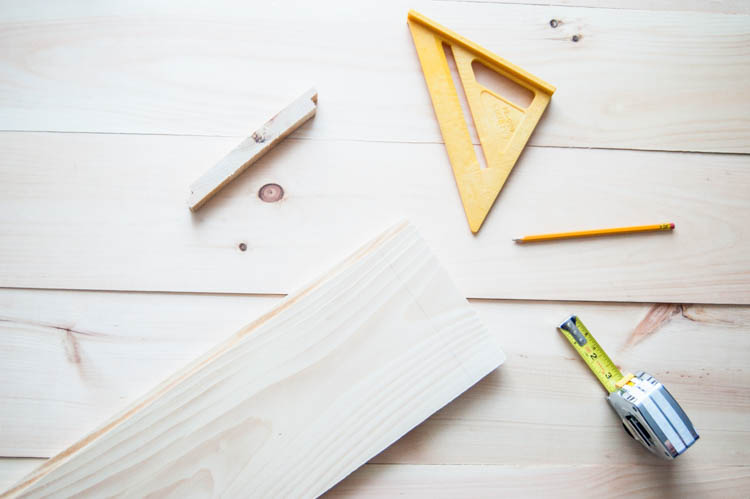
Step 1: In a well-ventilated area, while wearing a dust mask and goggles, cut your shiplap to create six planks that are each four feet long. These will be the visible planks above the box shelf.
Step 2: Cut the pine planks into the following box shelf materials. Once constructed, this box will rest just under the shiplap panels:
- (3) 4-foot pieces (for the top, bottom and back)
- (4) 9-and-11/16-inch pieces (for the sides and dividers)
- (1) 18-inch piece (for the door)
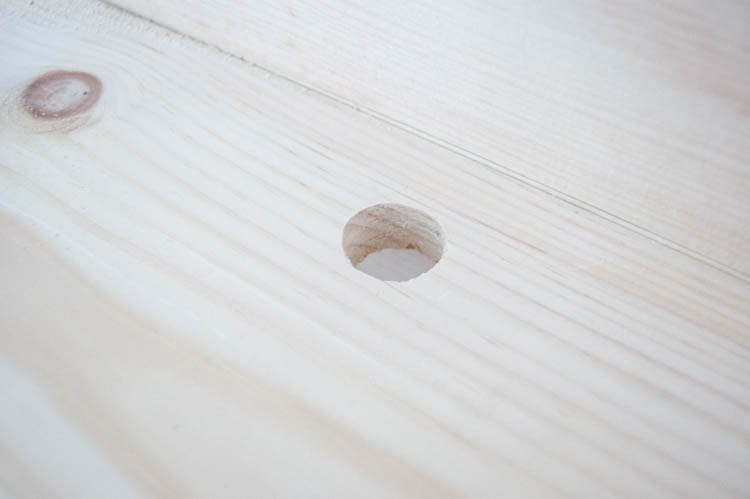
Step 3: Decide where your cord holes will go and drill them accordingly with the larger spade bit. If you plan to use an in-wall power cord and cable kit, which helps to route coaxial cables and power cords through the wall so they’re truly invisible, then you’ll only need one hole in your unit directly behind where the TV sits. We wove our cords through the unit to a power strip in the center shelf then through two dividers in the shelving so it would reach an outlet.
This meant we needed three spade bit holes: one in the top of the box just behind the TV, one in the divider that connects the middle section of the shelf to the right section and one from the right section out the side of the shelf. We then masked the few inches of visible power cord with a crate of extra blankets and throw pillows for aesthetic purposes.
Step 4: Use the smaller spade bit to drill a finger hole in the top center of the door.
Step 5: With a slightly damp cloth, wipe the rabbet (the tongue-like edging) to remove any dust from sawing and sanding. Give this a few minutes to dry, then paint the rabbet with your chosen paint color so you don’t have to try to paint in the grooves after the unit is hung. I didn’t paint the grooves ahead of time, but ended up wishing I had!
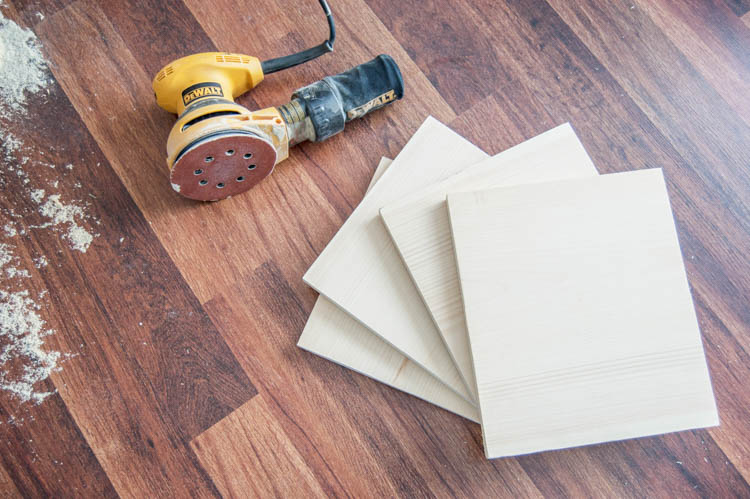
Step 6: Break out the sander and smooth those surfaces! This helps the paint stick and keeps the project looking polished.
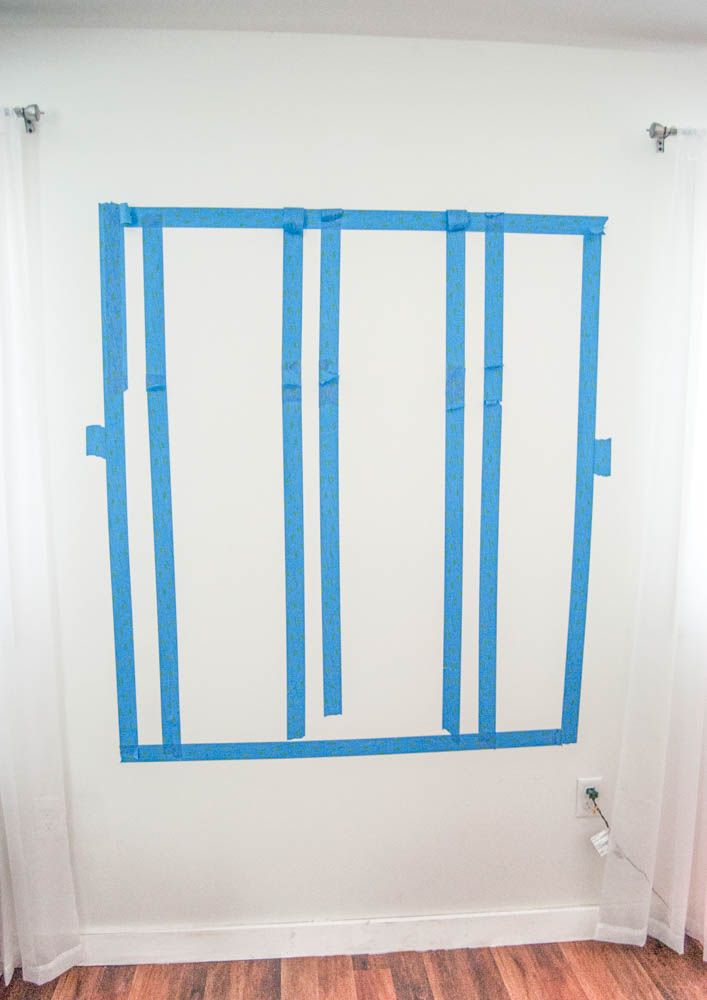
Step 7: Use the stud finder to locate the studs in your wall and mark them with a chalk line or painter’s tape. Then, using the dimensions of the unit itself, decide and mark its exact placement. We spread our unit across three studs to distribute the weight.
Step 8 (Optional): If you want to install the in-wall power cord and cable kit, now’s the time to work on that. Follow the instructions on your kit to completely hide all coaxial and power cables for your TV, cable box and consoles. This seamlessly integrates your electronics into the entertainment unit, but because of the placement of our unit and outlets, we could skip this step.
Step 9: Mark and drill pilot holes for the screws in your shiplap where it will meet the studs. Make sure you lay your boards out in the appropriate direction when you do this because the screw holes will probably not be centered. Do the same in the pine plank that will serve as the back of the shelf. I used two screws per board per stud for the shiplap and four cabinet screws per stud to attach the pine box shelf. After the pilot holes are drilled, use a countersink bit with your drill so you can fill in the holes later with wood putty to produce a seamless, floating look on the shiplap.
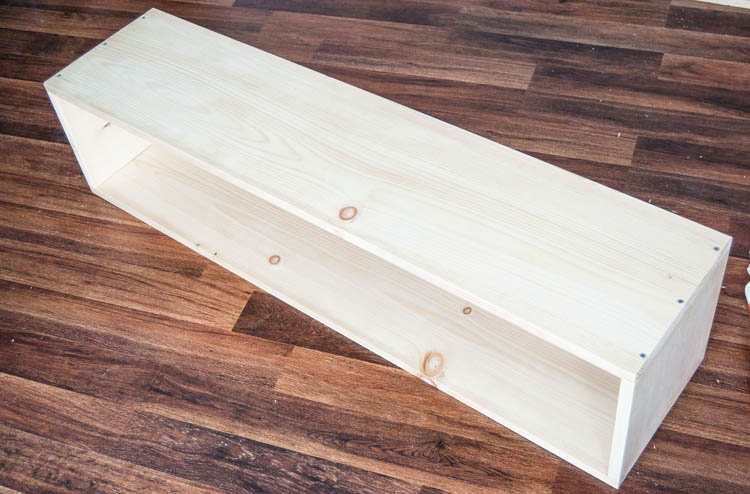
Step 10: Build the box shelf! Use wood glue and a clamp to join one of your 4-foot pine planks with a 9-and-11/16-inch board at a 90-degree angle. Adjoin these with wood screws, then remove the clamp. Use this same technique to attach the other two sides of the box shelf, wiping away any excess glue with a rag.
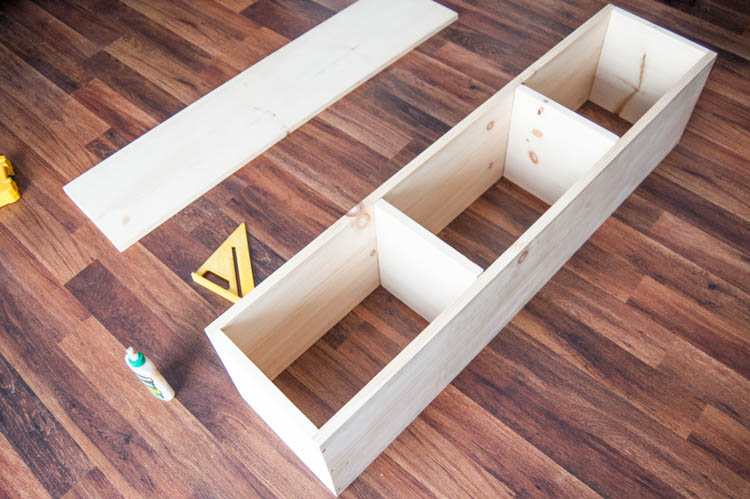
Step 11: Measure and mark where your shelf dividers will go, then secure them in place in the same manner as before.
Step 12: Turn the shelf front-side-down and securely attach the backing.
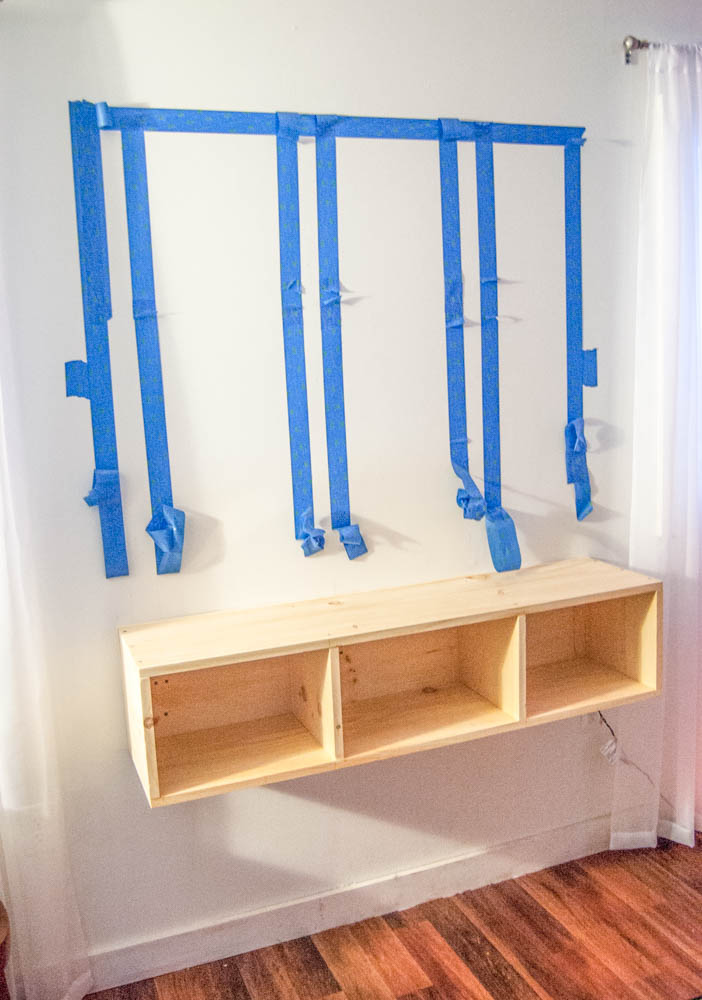
Step 13: Grab a partner to hold the shelf in place on the wall and, with the help of a level, screw the shelf securely into the studs.
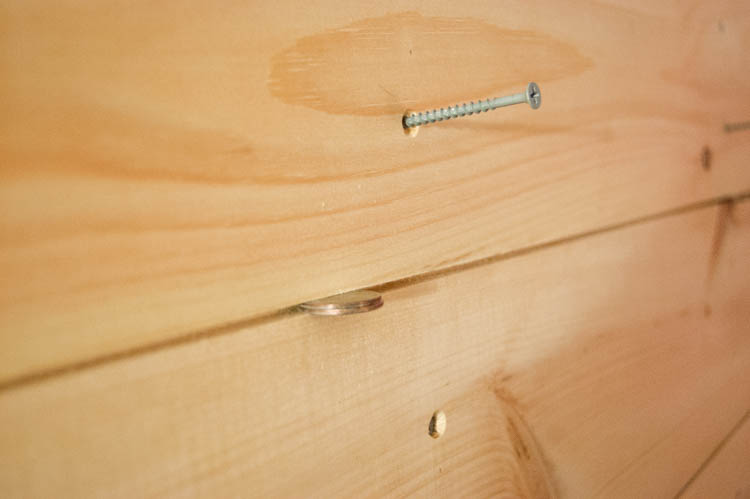
Step 14: From here, stack the shiplap one plank at a time directly above the shelf and screw through your pilot holes into the studs as you go. I wanted a little more groove visible than what was natural for this siding, so I used two stacked quarters as makeshift spacers in the grooves as I screwed the shiplap to the wall, but fence spacers would work, too. If you do the quarter trick, use four quarters (two toward each end) to ensure you’ve got a level groove.
Step 15: Follow the directions on your wood filler to repair the screw holes and any joints you don’t want visible (like the corners of the shelf portion). Once the wood filler has dried, sand it down.
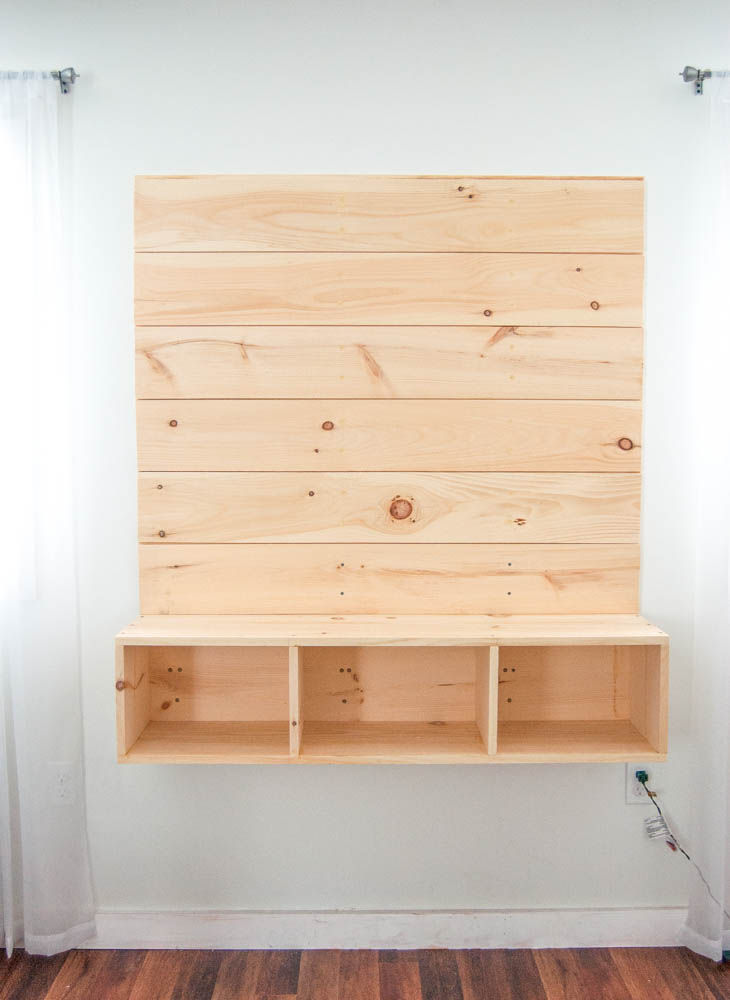
Step 16: Attach the door to the middle portion of the shelf with two small utility hinges attached to the bottom of the unit and a magnetic cabinet catch on the top inside of the door.
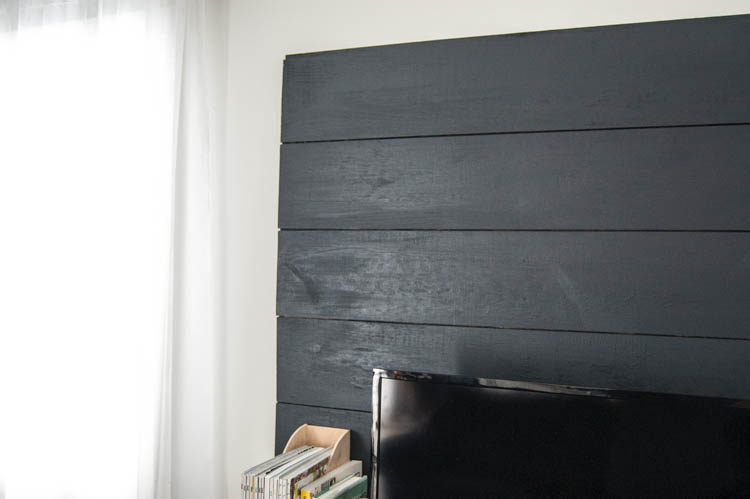
Step 17: Wipe away dust from screwing and sanding with a clean, damp rag. When the wood has dried, use a roller to paint the shiplap and a brush to get inside the shelf. You may need several coats of paint to cover the surface evenly.
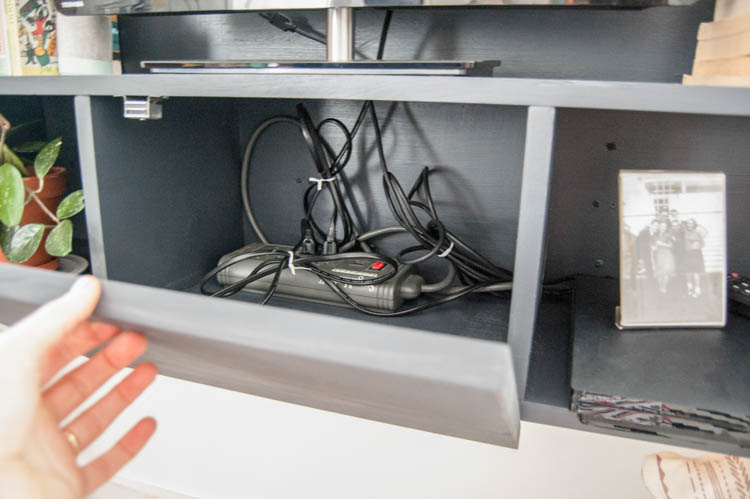
Once all the paint is dry, the fun part begins! Weave your coaxial wiring through the holes you’ve created so they’re invisible inside the center box and behind decor on the open shelves (twist ties can hold extra lengths in place), then style the shelves to your taste. Try hanging a boxwood wreath in the center of the shiplap or draping a banner between the top corners. This is a great place to easily swap out seasonal decor!
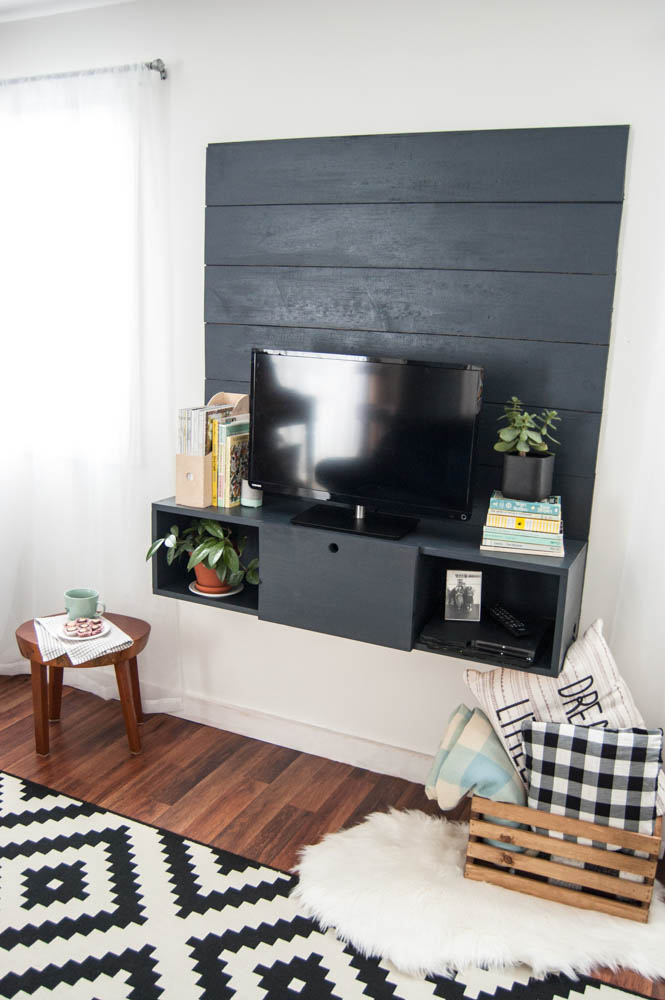
With all those distracting wires and devices corralled and a deep charcoal frame to camouflage your electronics, you’ll have more opportunity to add little touches of personality to your living area. Now pick a movie, pop some popcorn and prop those feet up to enjoy your brand new floating entertainment center!
Julia Marchand is a lake living, coffee consuming Mom who creates fun DIYs that she writes about for The Home Depot. Her DIYs always try to provide a solution to a problem, like she did with this article— hiding coax cable wires. Visit The Home Depot to see an array of coax cable options.





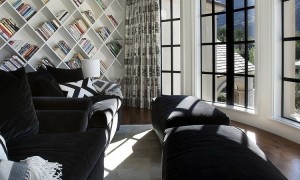

I love this!!
I am so glad! Let us know if you end up making it and we would love to feature it!